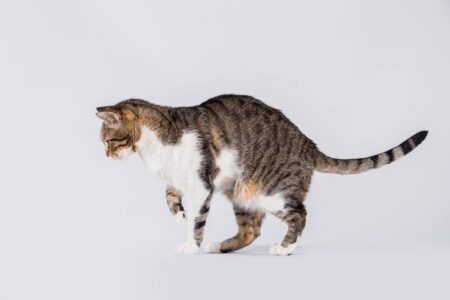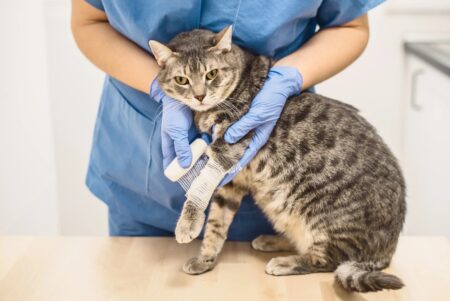
Ways to Help Your Cat Limping Back Leg to Health
As a cat owner, it can be distressing to witness your beloved pet limp on their back leg and this limping can be caused by several reasons like injuries, arthritis, or underlying medical conditions. Whatever the cause may be, it is important to take the appropriate action and help your cat alleviate their discomfort and regain their mobility. In this guide, we will discuss some ways to help your cat’s limping back leg to health like proper care and treatment, exercises, and lifestyle changes as being attentive and proactive can help in your cat’s recovery and improve their overall well-being.
Ways to Help Your Cat Limping Back Leg to Health
1. Take your cat to the vet:
The first step in helping your cat’s limping back leg is to take them to the vet for a thorough examination. The vet will be able to identify the underlying cause of the limp and provide appropriate treatment.
2. Follow the prescribed treatment plan:
If the vet prescribes any medication or recommends a specific treatment, it is crucial to follow their instructions. This will help speed up your cat’s recovery and prevent any further complications.
3. Give them a comfortable resting place:
Make sure that your cat has a comfortable and quiet place to rest while they recover. Provide a soft bed or cushion for them to lay on and keep their food, water, and litter box nearby.
4. Limit their physical activity:
It is essential to restrict your cat’s physical activity to allow the injured leg to heal. Avoid letting them jump or run, and keep them indoors for a few days.
5. Apply ice compress:
Applying an ice pack or a bag of frozen peas to the affected area can help reduce inflammation and pain. Wrap the ice pack in a towel and apply it gently for 10 to 15 minutes a few times a day.
6. Help them with grooming:
If the injury is making it difficult for your cat to groom themselves, you can help them by gently brushing their fur and keeping it clean. This will prevent matting and keep their coat healthy.
7. Use supportive devices:
Depending on the severity of the injury, your vet may recommend using supportive devices such as a splint or a bandage to help stabilize your cat’s leg while it heals.
8. Encourage gentle exercise:
Once your cat starts feeling better, you can encourage them to do some gentle exercise such as walking or using a scratching post to help strengthen their muscles.
9. Monitor their progress:
Keep a close eye on your cat’s progress and look for any signs of improvement or worsening. If you notice any changes, consult your vet immediately.
10. Provide a balanced diet:
A healthy and balanced diet is crucial for your cat’s overall health and recovery. Consult your vet for a recommended diet plan to support their healing process.
Cat Suddenly Limping Back Leg
If your cat is suddenly limping on its back leg, it is important to take them to the veterinarian for a thorough examination. There are a few potential causes for sudden limping in a cat’s back leg like injury or trauma, arthritis, or luxating patella and some of these may require medical attention.
My Cat is Limping But Acting Normal
Cats are naturally active and graceful creatures, so it can be concerning to see them limping. However, it is not uncommon for cats to have small injuries or strains that may cause temporary limping. In most cases, if your cat is still behaving normally, eating, drinking, and using the litter box, it is likely just a minor injury that will resolve on its own.
SEE ALSO: The Ultimate Guide to Flying with Large Dogs
Causes of Cat Limping Back Leg
There are several possible causes for a cat limping on its back leg, including:
- Muscle or Ligament Injury: A strain or tear in the muscles or ligaments in the cat’s leg can cause limping and difficulty walking. This can happen from jumping or playing too vigorously, or from slipping and falling.
- Arthritis: Just like humans, cats can develop arthritis, which can cause stiffness, pain, and limping in their joints. This is more common in older cats or those with underlying health conditions.
- Joint Dislocation: Cats can sometimes experience a dislocation of their hip or knee joint, usually as a result of an injury or trauma. This can cause a visible limp and may require medical intervention.
- Hip Dysplasia: This is a genetic condition where the hip joint is poorly formed, causing instability, pain, and limping. This is more commonly seen in certain breeds, such as the Siamese and Maine Coon.
- Sprain or Strain: Similar to muscle or ligament injuries, a sprain or strain can occur if the cat twists or overstretches a muscle or ligament in its leg. This can happen during play or exercise.
- Nerve Damage: Damage to the nerves in the leg can cause weakness, lameness, and limping. This can be caused by trauma or other underlying health issues.
- Bone Fracture: A fracture or break in a bone can cause severe pain and limp in cats. This can happen from a fall or other trauma or can be a result of weakened bones due to conditions such as osteoporosis.
When Should I Take My Cat to The Vet For Limping?
If your cat is limping beyond a day or two and you don’t know the cause, it is important to take them to the vet as soon as possible for limping can be a sign of a serious injury or illness, and the longer it goes untreated, the more it can worsen.
Cat Suddenly Limping Back Leg Treatment
The treatment for a cat suddenly limping back leg will depend on the underlying cause. The following are some possible treatments that may be recommended:
- Rest and restricted activity: If the limping is caused by a minor strain or sprain, the veterinarian may recommend rest and limiting the cat’s activity. This will give the affected leg time to heal on its own.
- Pain medication: In some cases, the vet may prescribe pain relievers to ease the discomfort and reduce any swelling in the leg. These medications may include non-steroidal anti-inflammatory drugs (NSAIDs) or other types of painkillers.
- Splint or bandage: If the limping is due to a fracture or other injury, the vet may recommend splinting the leg or applying a bandage to provide support and stability while the leg heals.
- Surgery: In more severe cases, surgery may be necessary to repair any fractures, torn ligaments, or damage to the muscles or tendons in the leg.
- Physical therapy: In some cases, physical therapy may be recommended to help improve muscle strength, flexibility, and mobility in the affected leg.
Natural Ways to Help Your Cat Limping Back Leg to Health
- Rest and Limited Activity: The first step in helping your cat’s limping back leg is to make sure they get plenty of rest. Encourage your cat to rest by providing a quiet and comfortable place for them to relax. Limit their activity and try to keep them from jumping or running until their leg heals.
- Apply Heat or Cold Therapy: Depending on the cause of the limp, either heat or cold therapy can help reduce pain and inflammation in your cat’s back leg. You can use a heating pad or a warm compress for about 15-20 minutes a few times a day. Alternatively, you can use an ice pack wrapped in a towel for the same amount of time.
- Gentle Massage: Massaging the muscles around your cat’s limping back leg can help improve circulation and reduce pain. Use gentle circular motions with one or two fingers in the affected area. Be careful not to press too hard and make sure your cat is comfortable during the massage.
- Natural Supplements: Several natural supplements can help reduce pain and inflammation in your cat’s back leg. Omega-3 fatty acids, glucosamine, and chondroitin are often recommended for joint health and can be easily added to your cat’s diet.
- Keep Your Cat’s Weight in Check: If your cat is overweight, it can put additional strain on their joints and make their limp worse. Make sure to monitor your cat’s weight and keep them on a healthy and balanced diet to help alleviate the pressure on their back leg.
- Provide Soft Surfaces: Make sure your cat has access to soft and supportive surfaces to rest on. This can include a padded cat bed or a soft blanket. These surfaces can help reduce pressure on their joints and make them more comfortable.
- Natural Pain Relief: If your cat is in pain, you can also try using natural pain relief options such as CBD oil or turmeric. These have anti-inflammatory properties and can help ease your cat’s discomfort.
How To Prevent Your Cat From Limping
- Regular veterinary check-ups: Taking your cat for regular check-ups with the vet can help identify any underlying medical conditions that could be causing the limping. This will allow for prompt treatment and prevent it from becoming a chronic issue.
- Avoid strenuous activities: Cats are natural athletes and love to jump and run. However, too much physical activity can put a strain on their joints, leading to limping. It is important to monitor your cat’s activity and prevent them from performing high-impact activities that could cause injury.
- Keep their environment safe: Ensure that your cat’s environment is safe and free from any potential hazards that could cause them to trip or fall, such as loose wires or sharp objects. This will minimize the risk of accidents and prevent limping.
- Monitor their diet: Maintaining a healthy weight is crucial for joint health in cats. Overweight cats are more prone to joint and muscle injuries, which can cause limping. Ensure that your cat’s diet is balanced and meets their nutritional requirements.
- Trim their nails: Overgrown nails can cause discomfort and make it difficult for your cat to walk properly, leading to limping. Regularly trim your cat’s nails to prevent this issue.
- Provide soft surfaces for resting: Make sure your cat has comfortable and soft surfaces to rest on, as hard or uneven surfaces can put unnecessary strain on their joints, causing limping.
- Use supplements: There are various dietary supplements available for cats that promote joint health and can help prevent limping. Consult your vet for recommendations on which supplements may be suitable for your cat.
- Prevent injuries: As a precaution, try to limit your cat’s exposure to potential injuries by keeping them indoors or in a safe, enclosed outdoor area. Outdoor cats are more prone to injuries from fights or accidents with other animals.
- Monitor older cats: As cats age, they become more prone to joint issues and arthritis, which can cause limping. Keep a close eye on your older cat and consult your vet if you notice any signs of limping or joint pain.
- Seek prompt treatment: If your cat does develop a limp, seek prompt treatment from your veterinarian to avoid any long-term damage. Delaying treatment can worsen the condition and lead to permanent limping.
SEE ALSO: Why Does My Cat Sleep Pressed Up Against Me?
FAQs
Q. Can a cat limp heal on its own?
It depends on the cause of the limp. If the limp is from a minor injury or strain, it may heal on its own with rest and time.
Q. How do you treat limping syndrome in cats?
To control limping syndrome in cats, soak the foot in warm Epsom salt water to relieve swelling. Then apply antibiotic ointment, such as Polysporin.
Q. How can I treat my cat’s broken back leg at home?
To treat a cat’s broken leg at home, a splint and heavy bandage may be applied as this will keep the limb in the correct and stable position whilst the bone heals.


